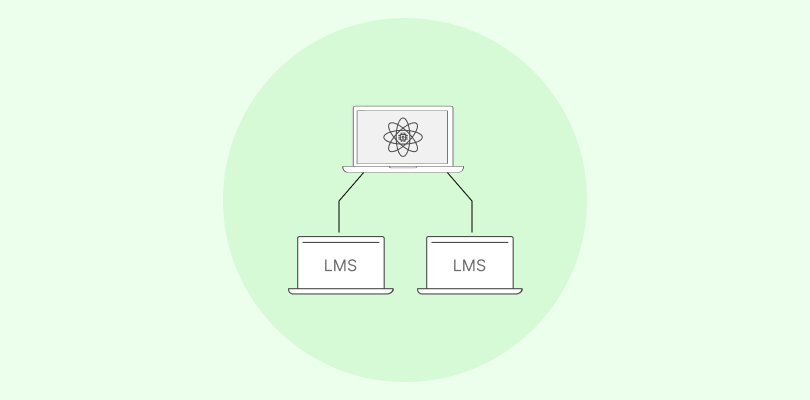Creating an impactful online course is the first step in successful eLearning.
But how do you ensure you get it right the first time?
This is what this post will be discussing: how to create an eLearning course.
Put in the right efforts where it matters most and achieve your goal of course creation faster.
Steps to Creating a Successful eLearning Course
“The biggest benefit of eLearning is the utter lack of pressure. Because you get to set your own schedule and study only when you have time, eLearning makes learning not something you have to get over with, but something you look forward to.”
Step 1: Pick the Right Topic
Step 2: Check the Market Demand
Step 3: Set SMART Goals
Step 4: Structure Your Course Modules
Step 5: Choose the Delivery Method & Platform
Step 6: Take Care of Recording & Editing
Step 7: Set the Pricing
Step 8: Launch Your Course
Step 9: Gather Feedback
Step 10: Build an Online Community
Step 1: Pick the Right Topic
The success of your eLearning course depends on the topic you choose, to a great extent. The topic should be relevant, engaging, and aligned with your target audience’s needs and interests.
Conduct thorough research to identify trending topics, gaps in the market, and popular subjects within your niche.
Consider conducting an online survey or engaging a focus group to understand the preferences and needs of your target audience better.
| Tip: Always choose a topic you’re passionate about. In addition to the depth of knowledge, you can maintain the motivation level throughout the process. It will also bring authenticity, long-term commitment, and personal fulfillment. |
Step 2: Check the Market Demand
It is essential to validate the market demand for your chosen topic before investing time and resources into creating an eLearning course.
Analyze keyword search volume, competition, and trends using tools like Google Trends or keyword research tools.
By understanding the market demand, you can ensure that there is sufficient interest and potential customer base for your course.
| Remember: Using professionally designed online market research survey templates can simplify your job of identifying the potential audience of your topic and the knowledge or skill areas in demand. |
Step 3: Set SMART Goals
Clearly define your goals for the eLearning course. Gain a clear understanding and articulation of what you want to accomplish through the course. This helps in guiding the design and development of the course content, activities, and assessments.
In particular, identify the following:
- learning objectives
- target audience
- scope
- content
- performance expectations
- available resources
- time
By clearly defining these goals, you provide a clear direction for the course and ensure that the design and delivery align with the desired outcomes for learners.
| Solution: Break down your overall goal into smaller, manageable milestones to track progress and stay focused. For this, you may utilize the SMART goal framework. This can help you create a course with a clear purpose and objectives. |
Step 4: Structure Your Course Modules
Your eLearning course design should not only appeal to learners but also serve the purpose.
Divide your course content into logical modules or sections to enhance learner comprehension and organization.
Use headers, sub-headings, and bullet points to visually structure the content within each section. This will make it more organized and reader-friendly.
Each module should have a clear introduction, learning objectives, well-structured content, interactive elements, and assessments to gauge understanding.
Course participants should understand the purpose and flow of the module to know the roadmap for their learning experience.
| Tip: Incorporate different multimedia elements like videos, quizzes, interactive activities, and downloadable resources to make the learning experience more engaging and diverse. |
Step 5: Choose the Delivery Method & Platform
To create eLearning courses, you should first know the delivery method and the tool to use.
Determine how you will deliver your eLearning course. Options include self-hosting on a website, utilizing a learning management system (LMS), or relying on a third-party online course platform.
All top-rated LMS tools support eLearning course development in the form of course creation, multimedia embeds, and personalized learning experiences. You can create eLearning courses for free with some of these platforms.
In addition, you can manage learner enrollment, track progress, and implement assessments and grading. These features ensure efficient course creation and delivery while monitoring progress and completion.
Whichever platform you choose, make sure you consider factors such as ease of use, customization options, payment processing, and marketing features.
| Remember: Choose a platform that aligns with your course requirements, budget, and technical abilities. |
Step 6: Take Care of Recording & Editing
Invest in proper equipment and software to ensure high-quality audio and video recordings.
This is vital if you want to create engaging eLearning courses.
Plan and script your content in advance to maintain a logical flow and avoid unnecessary tangents.
Edit your recordings to remove errors, enhance clarity, and improve overall production value.
Check out these trending video recording and editing software.
| Bonus: Consider enlisting the help of a professional editor or using user-friendly editing software to streamline the process. |
Step 7: Set the Pricing
The pricing of a course is vital for both course creators and their audiences.
From a course creator’s point of view, it directly impacts resource allocation, revenue generation, and value perception. The final price should include the cost of eLearning development.
Similarly, from the perspective of the audience, pricing determines the affordability and value for money besides creating a sense of commitment and motivation for learners.
Determine the appropriate pricing model for your eLearning course. Consider factors like course content quality, market competition, target audience’s affordability, and value provided.
Take into account whether you will offer tiered pricing, bundle options, or any promotional discounts.
| Tip: Consider offering a free trial or a money-back guarantee to increase customer trust and enhance conversions. |
Step 8: Launch Your Course
Plan and execute a well-structured course launch strategy to create buzz and attract learners.
Develop a compelling sales page highlighting the unique selling points and benefits of your course.
Effective marketing strategies are another area to pay attention to. It can increase course visibility through measures such as social media promotion, email marketing, and partnerships with industry influencers.
Finally, establish credibility by showcasing testimonials and leveraging your expertise.
| Remember: Provide clear instructions for accessing the course after purchase to prevent any confusion or frustration. |
Step 9: Gather Feedback
Regularly collect feedback from your learners to enhance the quality of your eLearning course.
Implement surveys, quizzes, and feedback forms to gather insights about what works well and areas for improvement.
By analyzing the feedback, you can make necessary adjustments, updates, and enhancements to the course content, delivery, or user experience.
| Solution: Create a supportive environment that encourages learners to provide honest feedback and suggestions. |
Step 10: Build an Online Community
Finally, foster a sense of community among learners by creating platforms for interaction and collaboration. This can include discussion forums, social media groups, or live Q&A sessions.
They can encourage learners to connect, share their experiences, ask questions, and learn from one another.
Building an online community around your online courses this way can greatly enhance the learning experience and engagement of your audience.
For this, you should:
- choose the right platform
- clearly define your community’s purpose
- encourage active participation
- create a sense of belonging
- offer exclusive content & resources
- foster networking opportunities
Along with this, you should be an active facilitator within your online community as a course creator and community leader.
Continuously seek feedback from your community members to understand their needs and improve the community experience. Incorporate suggestions and iterate on your strategies to ensure the community remains engaging and valuable.
| Tip: Building an online community takes time and effort. Be patient and consistent in nurturing and growing your community. Actively participate in the community, provide timely responses, and facilitate valuable discussions. |
Case Study: How Health First created & shared online training courses in an organized way.
Create Your First eLearning Course
“eLearning is not a choice, but a necessity for every forward-thinking organization.”
That’s all about how to create an eLearning course.
These steps are tried and tested, easy, and practical. They cover everything from conceptualization to implementation and analysis. So, by following them strictly, you will be on your way to seeing successful eLearning courses.
Remember, creating an eLearning course requires careful planning and strategies. Among others, pick your course topic wisely, conduct market research, and choose the right platform.
Create eLearning courses that meet the needs of your learners and achieve your business objectives at the same time.
If you’re looking for an eLearning authoring software system to start creating courses, help is just around the corner. Get started free or request a personalized demo.
Frequently Asked Questions
Why should I consider creating an eLearning course?
Creating an eLearning course allows you to reach a wide audience with scalable and flexible learning opportunities. It caters to diverse learning styles with multimedia content and interactive elements, and offers learners the convenience of personalized pacing. Additionally, it can be a cost-effective way to deliver education or training and reduce the need for physical materials and classroom space.
How do I structure an eLearning course?
Structure your eLearning course by first defining clear learning objectives. Break the content into manageable modules or units, each focusing on specific topics that align with the overall goals. Incorporate a mix of multimedia elements such as text, videos, and interactive activities to engage learners. Ensure there’s a logical flow from one section to the next, and include assessments to measure learners’ progress.
What is the first step in creating an eLearning course?
The first step is to conduct a needs analysis. This involves identifying your target audience, understanding their learning needs, preferences, and challenges, and defining the learning objectives of the course. This foundational step ensures that the course content is relevant, meets the learners’ needs, and aligns with the desired outcomes. To get started,watch: How to Create an Online Course from Scratch (With Ravi Roy)
How do I choose the right eLearning platform?
Consider factors like ease of use, scalability, and compatibility with multimedia content. Assess the platform’s ability to support your course’s interactive and assessment needs. Also, consider the cost, technical support, and feedback from other users. It’s important to select a platform that aligns with your learning objectives and audience’s needs.
For more, watch: How to Choose the Best LMS Software for Employee Training
What are some essential elements to include in my eLearning course?
Interactive content, multimedia, assessments and quizzes, clear learning objectives, and feedback mechanisms are some of them. Incorporating social learning aspects, such as discussion forums and group projects, can also enhance engagement. Accessibility features to accommodate diverse learners are crucial.
Is it necessary to update my eLearning course after launch?
Yes, it is. Continuous updates ensure that the course content remains relevant, accurate, and aligned with the latest industry trends or educational standards. Regularly solicit feedback from learners and monitor course performance metrics to identify areas for improvement. Updating the course can also help in incorporating new technologies or learning methods to enhance the learning experience.
 Tips
Tips
We’d love to hear your tips & suggestions on this article!
Get Free eLearning Authoring Software — All Features, Forever.
We've helped 567 companies train 200,000+ employees. Create courses in under a minute with our AI LMS or use 200+ ready-made courses on compliance, harassment, DEI, onboarding, and more!

 We'd love your feedback!
We'd love your feedback! Thanks for your feedback!
Thanks for your feedback!







